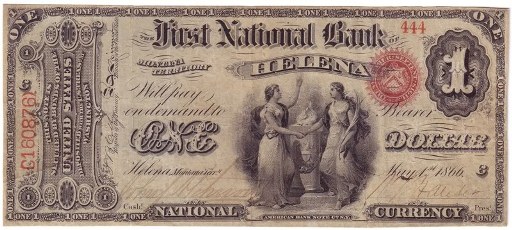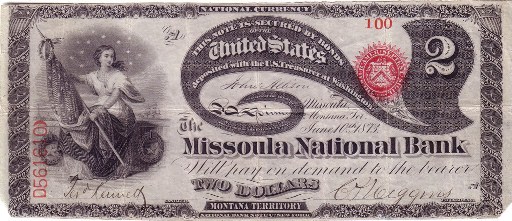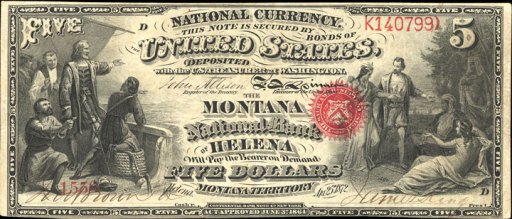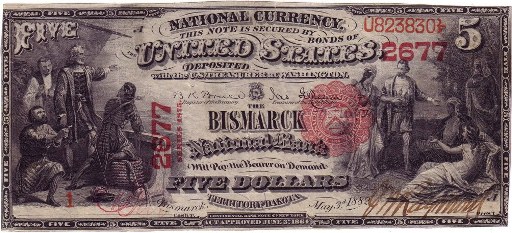The First National Bank Of Yankton
The First National Bank Of Yankton in South Dakota printed $602,100 dollars worth of national currency. That is a high amount, but condition and serial numbers can make otherwise common currency from this bank quite valuable. This national bank opened in 1872 and stopped printing money in 1935, which equals a 64 year printing period. That is considering a long operation period for a national bank. During its life, The First National Bank Of Yankton issued 10 different types and denominations of national currency. We have examples of the types listed below. Your bank note should look similar. Just the bank name will be different. For the record, The First National Bank Of Yankton was located in Yankton County. It was assigned charter number 2068.
We buy all national currency. Please call or email us for a quote. Sales@AntiqueMoney.com
The First National Bank Of Yankton in South Dakota issued 1,500 sheets of $1 original series territorial national bank notes. A total sheet output in the lows 1,000s is a great sign that you own a very rare bank note. When dealing with any first charter one dollar bank note, you can always take the number of sheets printed and multiply it by three to get the total number of actual bank notes printed for this denomination. These are technically called original series one dollar territorial national bank notes. Most collectors just call them territorial aces. Believe it or not, they are actually quite available. Around 100 of them are known to exist. Thanks to small hoards from towns like Salt Lake City, Yankton, and Denver, a collector can buy a nice looking territorial ace without spending tens of thousands of dollars. The rarest examples will certainly still cost more than $10,000, but others can seem like bargains.
Original Series $1 Territorial National Bank Note
The First National Bank Of Yankton printed 1,500 sheets of $2 original series territorial national bank notes. Keep in mind that there was just one two dollar bill printed per sheet. So in this case the sheet number equals the total output of notes. Just like with the one dollar denomination, original series $2 territorial bank notes have survived at a surprisingly high rate considering they were only issued by 19 different national banks. The good news for sellers is that these are still really valuable. Prices are as low as $10,000 for something ugly and relatively common. It is possible for the rarest examples to be worth more than $50,000.
Original Series $2 Territorial National Bank Note
The First National Bank Of Yankton also printed 3,000 sheets of $5 original series territorial national bank notes. Many territorial banks had outputs in the 2,000 to 4,000 range. You can do some quick math and take the sheet output, multiply it by four, and get the total number of original series $5 territorial bank notes issued by this bank. Only 30 banks in the country even printed these notes. Today there are only about ten surviving examples known to exist. Most of them are low grade and they are rarely available on the collector market. We are talking about bank notes printed before 1875, so the number of new discoveries being found 140 years later is minimal. Prices range from a few thousand dollars to tens of thousands of dollars based on any number of valuation factors.
Original Series $5 Territorial National Bank Note
The First National Bank Of Yankton also printed 5,976 sheets of $5 series of 1875 territorial national bank notes. That printing range is high enough to allow for a couple of survivors, but not much more. Most first charter five dollar territorials that we encounter today are from the series of 1875. Despite saying series of 1875, these were actually printed as late as 1901 by a handful of banks. So while these might appear ancient, some are much newer than the series date would suggest. With that said, these are still rare items treasured by collectors. Exactly 42 national banks printed series of 1875 five dollar territorials. That list of banks pretty much included all of the territories from Arizona to Wyoming. Please give us a chance to help you establish the value of your note. You will likely be pleasantly surprised with how these bank notes are valued in today’s market.
Series of 1875 $5 Territorial National Bank Note
The First National Bank Of Yankton also printed 1,130 sheets of $10 1882 brown back national bank notes. That sheet output number is small. Don’t expect too many of these to be available to collectors. There were three $10 bills printed on a single sheet of 1882 brown backs. The design of the bill is similar to all earlier ten dollar national bank notes. The nickname comes from the fact that these bills have a brown seal and brown overprint. Despite saying series of 1882, these were actually printed by some banks up until 1908. The date you see in cursive relates to when the bank first started issuing brown back notes.
Series of 1882 $10 Brown Back
The First National Bank Of Yankton also printed 1,130 sheets of $20 1882 brown back national bank notes. As you can see, the sheet output is the same for $20 brown backs as it is for $10 brown backs. There was only one $20 brown back printed on a sheet. So the sheet output also equals the total note output. One neat thing about all brown backs is that they each have a different back design based on which state issued them. The back left hand side of the note shows the state seal of which ever state the national bank was located in. Generally speaking, 1882 $20 brown backs are pretty difficult to locate. They typically were printed in small numbers and they don’t have a great survival rate.
Series of 1882 $20 Brown Back
The First National Bank Of Yankton also printed 2,117 sheets of $10 1882 blue seal national bank notes. 1882 blue seals are traditionally not the most popular national bank notes. However, when we are talking about such a low print number, these become much more desirable. All of these notes say series of 1882 but they were actually printed between 1908 and 1921. So they aren’t quite as old as the dates might suggest. There is also a date on these notes that is between 1888 and 1901. That date is written in cursive text and it represents when the bank was chartered or re-chartered. Some of the so called 1882 value back notes have a chance to be really rare. Most of the earlier notes that say 1882-1908 on the back are likely going to be relatively common. The designs are exactly the same on the front. Each has a blue seal and charter number.
1882 Blue Seal $10 National Bank Note
The First National Bank Of Yankton also printed 2,117 sheets of $20 1882 blue seal national bank notes. That is the same number of sheets as the ten dollar denomination. You don’t have to multiply by three to get the exact number of notes issued though. There was only one twenty dollar bill per sheet. As with any national bank note, the exact value is still based on the condition, serial number, and bank of issue.
1882 Blue Seal $20 National Bank Note
The First National Bank Of Yankton also printed 991 sheets of $50 1902 blue seal national bank notes. There is no trick to knowing which 1902 blue seals will be common and rare. Often times the number printed won’t tell you much information. The value still comes down to condition and demand. That is a surprise to most people. In fact, most 1902 $50 bills we see are worth between $750 and $1,250. The rarer ones can be worth more than $5,000. However, there isn’t much middle ground.
1902 $50 Blue Seal National Bank Note
The First National Bank Of Yankton also printed 991 sheets of $100 1902 blue seal national bank notes. It is no coincidence that the sheet numbers for $50 bills and $100 bills are the same. They were printed on the same sheets. Most $100 blue seals are at least scarce; others can be very rare. John J Knox is printed on the front of each bill. Most collectors like the back design a lot more though. It is really unique and different from most other national bank notes. Prices for 1902 $100 blue seals are pretty similar to $50 blue seals. They are both equally common or equally rare, depending on how you look at it.
1902 $100 Blue Seal National Bank Note



